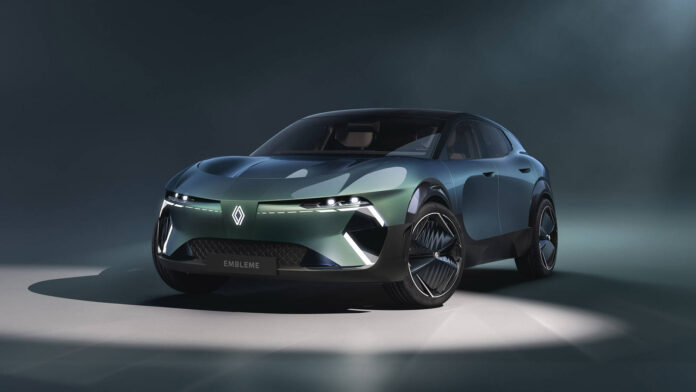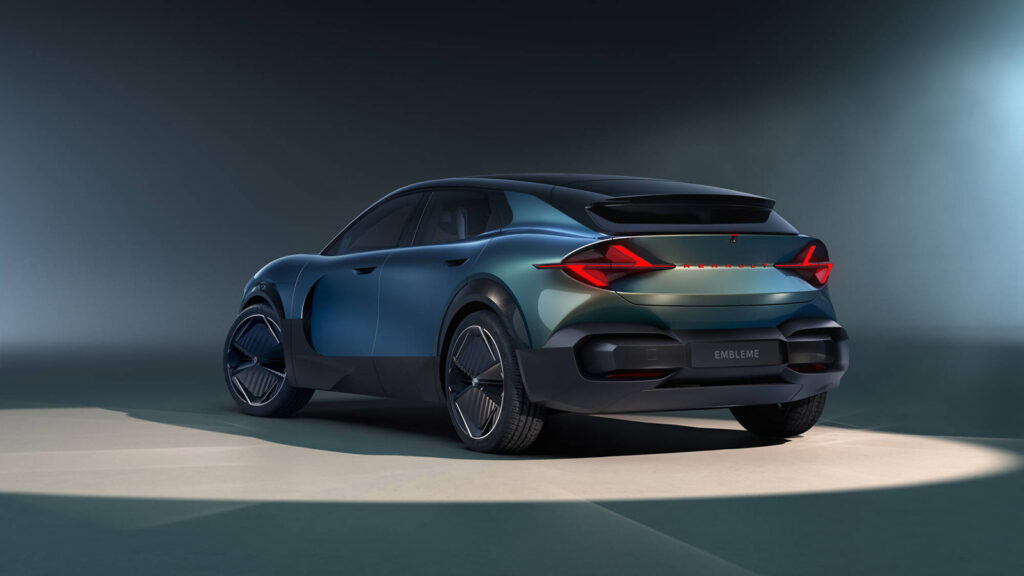
Decarbonising mobility is a key objective in the fight against climate change. For an automotive company such as Renault Group, it involves addressing a number of challenges relating to industry, energy, technology, supply, speed, and so on. To achieve net zero carbon by 2040 in Europe and 2050 worldwide, in line with its targets, the company needs to revolutionise the way it designs and builds its vehicles.
This approach is demonstrated by Renault Emblème displayed by the brand on its stand at the Paris Motor Show from 14 to 20 October. This vision of a family vehicle is a laboratory showcasing the innovations developed by Renault, Ampere and their partners to meet these requirements.
The main challenge of this landmark project lies in the extent to which decarbonisation has been maximised across the entire life cycle of the vehicle, from cradle to grave. Following on from the Scenic Vision H2-Tech concept in 2022, Renault Emblème takes the approach one step further, slashing greenhouse gas (CO2 eq.) emissions by 90%, compared with an equivalent vehicle built today; to produce just 5 tonnes of CO2 eq. from cradle to grave (see methodology section at the end of the press release).
To achieve this, the project explored a multitude of intelligent, credible and viable combinations: recycled materials with a low carbon footprint, natural materials, production processes relying entirely on renewable energy, general implementation of re-used parts and circularity, etc. The same was true of the technical choices, including the powertrain.
Efficiency at the heart of Renault’s new design language
Renault Emblème symbolises a new holistic approach to vehicle design. Its exterior design blends sportiness, elegance and emotion through sensual curves and graphic, technical character lines, creating an ultra-desirable object. The design is also the result of meticulous optimisation of aerodynamics, designed for efficiency through a more sustainable approach without compromising on aesthetics.
On Renault Emblème, for example, the exterior rearview mirror is replaced by two cameras integrated into the wheel arches, with windscreen wipers concealed under the bonnet and e-latch handles recessed into the bodywork. Two fins on the bonnet and two air vents on the bumper channel the airflow towards the windscreen and behind the wheels, respectively.
The wheels are full disc, in order to conduct the air flow along the body. The F1-inspired flat-bottom design is enhanced by an active diffuser, which tilts downwards and to the rear to balance the airflow and minimise aerodynamic drag.
The design was fine-tuned using digital twin technology and state-of-the-art digital simulation equipment provided by the BWT Alpine F1 Team, as part of a fruitful collaboration between Renault and Ampère. By pooling their expertise, they were able to optimise passive and active aerodynamics for efficient air penetration. Renault Emblème has a very good Cx of 0.25.

The elegance of a family shooting brake making no compromises on efficiency
Renault Emblème‘s strong curves and shooting brake style are showcased by the dichroic effect of the green bodywork, making the colour look different depending on the angle from which it is viewed. The vehicle is an elegant combination of an estate, with a wide wheelbase of 2.90 metres, and a coupé with a moderate height of 1.52 metres and flowing roofline.
The vehicle is 4.80 metres long, making it ideal for comfortable family travel, with passengers and luggage. It also symbolises Renault’s reaffirmed ambition to continue innovating in the C segment and higher, in line with its value-based strategy. Exploring new paths in design inspired by the iconic Renault logo, the light signature is intended to be both high-tech and easily identifiable.
A vehicle’s weight, which is partially linked to its size, impacts its CO2 eq. emissions at several levels: when materials are extracted, during production and transport, during use (impact on energy consumption) and when the vehicle is recycled. As part of their eco-design approach, the designers and engineers hunted down every superfluous kilogram, with the aim of reaching a weight of 1,750 kg, including batteries. Renault Emblème therefore weighs less than most hybrid SUVs or electric vehicles of similar size.
A powertrain combining versatility and low carbon performance
Renault Emblème has a dual power energy electric powertrain powered in two ways: by a “conventional” rechargeable battery, sufficient for everyday use, and by a hydrogen fuel cell for longer journeys. Based on the AmpR Medium platform, the rear-wheel drive architecture hosts the various powertrain components (electric motor, battery, fuel cell and hydrogen tank) while maintaining a low centre of gravity and ideal weight distribution to promote performance and efficiency.
Emblème‘s 160 kW wound-rotor electric motor uses no rare earths. It is powered by a small NMC battery (40 kWh), which is lighter, cheaper, less bulky and more environmentally friendly than that of a long-range family electric vehicle. It has a range of several hundred kilometres, more than enough for everyday journeys. The 30 kW PEMFC fuel cell runs on low-carbon hydrogen via a 2.8 kg tank, providing the power required for long journeys, with maximum efficiency of around 60%.
This configuration maximises the versatility of this type of vehicle, which is able to cover a distance of up to 1,000 km as rapidly as an ICE vehicle: without charging but with just two stops for hydrogen refuelling – less than five minutes each time – for a range of 350 km. On a typical journey between Paris and Marseille, 75% of the electricity consumed by the vehicle is produced by the fuel cell, with no emissions other than water.
An innovative working method
In view of the ambitious decarbonisation goals, the Emblème demo car required new working methods. More than 20 partners, all experts in their own fields, worked on the project with Renault and Ampere. Each one contributed their own technology or expertise to slash CO2 eq. emissions by 90% over the vehicle’s entire life cycle.
This collective horizontal approach encourages innovation without barriers between the Group, its brands, entities, partners and suppliers. For this project, this approach made it possible to harness exceptional technological diversity and complexity to achieve high decarbonisation targets.
The Emblème demo car shows once again that Renault Group is at the forefront of innovation, driving progress in mobility and the automotive industry in general, making its entire ecosystem part of the process. Ampere will unveil this car in full at the end of October.







